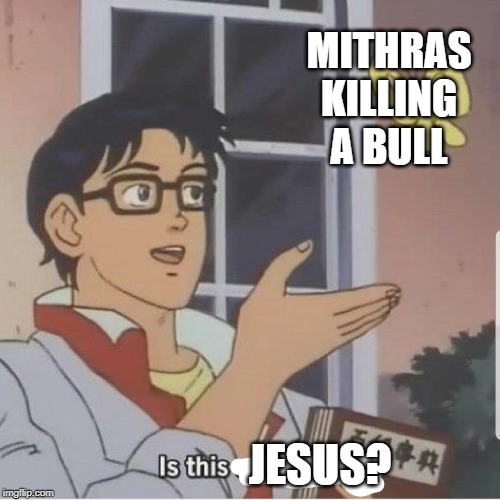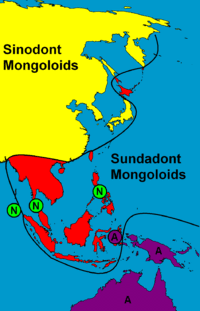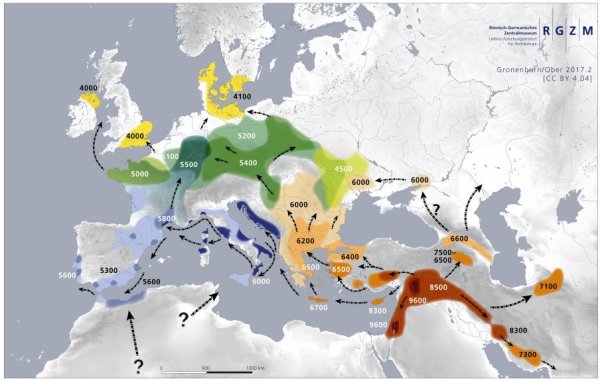
A paper has just been released on the first ancient DNA recovered from central African burials: Ancient West African Foragers in the Context of African Population History, by Lipson, Ribot, Reich, et al. This is exciting news because our ancient genetic coverage of central Africa has been, until now, completely nonexistent. The local climate tends to degrade human remains quickly, making it difficult to recover DNA, and most genetics researchers don’t live in Africa.
Researchers have recovered the remains of four people, two from about 8,000 years ago and two from 3,000 years ago, buried in Shum Laka, Cameroon. (Cameroon is the country right in the big turn in the curve of Africa’s coast; Shum Laka has been inhabited by humans for about 30,000 years.) The really interesting part is the “ghost population,” which we’ll get to soon.
The burials turned out to be Pygmy people, not Bantus, despite the belief among linguists that Cameroon is the Bantu homeland. From the paper:
One individual carried the deeply divergent Y chromosome haplogroup A00, which today is found almost exclusively in the same region12,13. However, the genome-wide ancestry profiles of all four individuals are most similar to those of present-day hunter-gatherers from western Central Africa, which implies that populations in western Cameroon today—as well as speakers of Bantu languages from across the continent—are not descended substantially from the population represented by these four people. We infer an Africa-wide phylogeny that features widespread admixture and three prominent radiations, including one that gave rise to at least four major lineages deep in the history of modern humans.
And then we hit the paywall. Thankfully, Science Magazine has a summary.
The Bantu language group is a branch of the larger Niger-Congo language family, one of the biggest (along with Indo-European and Sino-Tibetan) language families in the world. Niger-Congo contains about 1,740 languages (depending on how you count) with 700 million speakers. The Bantu branch accounts for half of them, or 350 million people.
The Bantu branch has clearly undergone a massive expansion over the past 3,000 years. 4,000 years ago, central Africa belonged to the Pygmies, Bushmen, and their relations. Today, those populations are tattered remnants of their former empires; the Bantus are dominant. The Bantu expansion is thus one of the great conquering events of recent history, comparable to the Indo-European expansion. The size of the Pygmy and Bushman population has consequently collapsed, though at what speed, we don’t know.
The presence of a significant Pygmy population in the supposed Bantu homeland back when the Bantu speakers were gearing up to conquer a huge chunk of the Earth’s surface indicates that Cameroon might not actually be the Bantu homeland. Of course there are easy fixes to this theory, like “the region just to the west of Cameroon is the Bantu homeland” or “there are still Pygmies in Cameroon today; researchers just happened to find some Pygmies,” but I propose a different possibility: the Bantu homeland is in the Sahara.

Yes, the Sahara is an enormous desert–today. Before 3,500 BC, the Sahara was significantly wetter. The Niger-Congo speakers started as agriculturalists who farm along the edge of the Sahara. During the African Humid Period, 3,500 years ago and before, much of the Sahara was green, full of plants and animals, flowing rivers and giant lakes. I propose that the Bantu homeland was in the vicinity of lake “Megachad,” which aside from having a great name, was an enormous lake in central Chad, overlapping the borders of Nigeria, Cameroon, and Niger, fed by a suitably extensive network of tributaries. Today, only remnants of the lake remain.
The drying of the Sahara and Lake Megachad turned the Bantu’s homeland to dust; just based on the African topography and modern rivers, they probably headed into northern Cameroon, eastern Nigeria, and the Central African Republic. The area of Cameroon where these pygmy skeletons have been found looks a little harder to get to, cut off from the north/east by highlands. This area may have therefore been a bit of a refugia during the Bantu expansion.
I think it is common for people to think of African populations as relatively homogeneous because it is the origin point from which humanity spread to Asia, Europe, Australia, the Americas, etc. But Africa isn’t a point. It’s big, and people spread out and wandered around Africa for thousands of years before some of them headed north.

The oldest extant human splits aren’t between Africans and non-Africans, but between Pygmies/Bushmen and everyone else. This split happened around 250,000 years ago. This was followed by more splits within Africa, like the one between West and East Africans about 150,000 years ago, and the out-of-Africa event about 70,000 years ago. Here’s a mostly-accurate tree diagram, Bushmen and Pygmies on the right:
(The big inaccuracy in this diagram is the yellow line representing Eurasian back-migration leaving genetic traces in modern Bushmen/Khoisan peoples. That never happened; the results turned out to be a computer error.)
Before the Bantu expansion, Pygmies and Bushmen were among the biggest ethnic groups on the planet. The extremely high Baka Pygmy population on this graph is probably partially due to high genetic diversity due to the merger of multiple long-separated groups rather than a massive Pygmy boom and then genocide, but I think it is still fair to conclude that relatives of today’s Pygmies and Bushmen once controlled most of central and southern Africa.

From Whole-genome sequence analysis of a Pan African set of samples reveals archaic gene flow from an extinct basal population of modern humans into sub-Saharan populations, by Lorente-Galdos et al.
(Today, the biggest ethnic group is the Han Chinese.)
From the Science article:
In the new study, geneticists and archaeologists took samples from the DNA-rich inner ear bones of the four children, who were buried 3000 and 8000 years ago at the famous archaeological site of Shum Laka. The researchers were able to sequence high-quality full genomes from two of the children and partial genomes from the other two. Comparing the sequences to those of living Africans, they found that the four children were distant cousins, and that all had inherited about one-third of their DNA from ancestors most closely related to the hunter-gatherers of western Central Africa. Another two-thirds of children’s DNA came from an ancient “basal” source in West Africa, including some from a “long lost ghost population of modern humans that we didn’t know about before,” says population geneticist David Reich of Harvard University, leader of the study.
I spent a while trying to figure out what this is saying, because it isn’t clear. First, I doubt they found that the 8,000 year olds were cousins to the 3,000 year olds. The notes in the extended data section of the paper claim to have found a nephew/aunt or niece/uncle relationship between two of the children; the other two were less closely related–possibly cousins.
This doesn’t tell us which skeletons they got the DNA from, but it turns out that one of the good ones was 8,000 years old.
The article claims that 1/3 of their DNA came from ancestors related to the [Aka] Pygmies and 2/3s from “basal West Africans”, who are also closely related to the modern Bantus.
This is confusing because it makes it sound like these children were a cross between Aka Pygmies and Bantus, and that the’re 2/3s Bantu, in which case they’d be more Bantu than Pygmy and this really wouldn’t upset the idea of Bantus in Cameroon.

The thing they didn’t say–and I only figured out from looking at the extended data–is that the modern Aka are not 100% “ancestral pygmy.” They are also part “basal West African.” (41% pygmy ancestor and 59% BWA, to be exact.) This is actually quite similar to the 1/3 and 2/3s found in the burials in Shum Laka. So there probably was an event where people related to modern Bantus mixed with an ancient Pygmy population, and their descendants include both the modern Aka Pygmies and the Shum Laka children.
The Aka Pygmies now live near the border between Cameroon and the DRC. (The “ba-” suffix, found in names like Bantu, Baka, and Batswana, means “people,” so “Baka” just means “Aka People.” Batswana means “Tswana people;” “bo-” means land, so Botswana is “Land of the Tswana.”)
The Mbuti Pygmies, whom you have probably also heard of, live much further from the Cameroonian border and have less Bantu DNA. The Mbuti Pygmies average only 4’6″, while the Aka Pygmies average a couple more inches. The average Aka man stands about 4’11”; the women a little less. Don’t fall into the trap of thinking that the Aka aren’t “real pygmies”–they’re still very short by modern standards, and as this paper shows, the mixing that created them occurred over eight thousand years ago. The Aka have been a distinct ethnic group for an extremely long time.
People always ask why the Pygmies are so small, but I think this question is backward. Bushmen are also short (compared to Dinka and Norwegians); I think our common human ancestors were only about 5′ tall. The pygmies got a little shorter, yes, but not by much; the rest of us got taller.

Now, the really interesting thing in this paper is the identification of three “ghost” populations.
First we have the Ghost Archaic:
The Ghost Archaic was a species similar to Neanderthals, but in Africa. We don’t have any skeletal remains from this species because of the aforementioned climate difficulties, but its DNA shows up in groups like the Mende and Yoruba of West Africa. Here’s the relevant paper, Recovering Signals of Ghost Archaic Introgression in African Populations:
Using 405 whole-genome sequences from four sub-Saharan African populations, we provide complementary lines of evidence for archaic introgression into these populations. Our analyses of site frequency spectra indicate that these populations derive 2-19% of their genetic ancestry from an archaic population 15 that diverged prior to the split of Neanderthals and modern humans.
That’s a lot of archaic! Since the populations with the highest rates of ghost archaic live in far West Africa, I assume the Ghost Archaic did, too.
Next we have the Ghost Modern, which I regretfully did not realize is different from the Ghost Archaic when I first wrote about it.
Here, we examine 15 African populations covering all major continental linguistic groups, ecosystems, and lifestyles within Africa through analysis of whole-genome sequence data of 21 individuals sequenced at deep coverage. … Regarding archaic gene flow, we test six complex demographic models that consider recent admixture as well as archaic introgression. We identify the fingerprint of an archaic introgression event in the sub-Saharan populations included in the models (~ 4.0% in Khoisan, ~ 4.3% in Mbuti Pygmies, and ~ 5.8% in Mandenka) from an early divergent and currently extinct ghost modern human lineage.
The Ghost Archaics were in the genus Homo, just like Homo erectus, Homo Neanderthalis, but they were not Homo sapiens. The Ghost Moderns were Homo sapiens. They split off from the rest at about the same time the Pygmies, Bushmen, and everyone else went their separate ways.
The Ghost Moderns later contributed to the ancestors of the Niger-Congo people of West Africa and the Mota burial, a 4,000 year old burial from Ethiopia. A branch later split from the Niger-Congo people, creating the “Basal West Africans” and carrying the Ghost Modern DNA (and a bit of the Ghost Archaic) with it. That branch eventually contributed to the Aka Pygmies, including the children found at Shum Laka.
The third ghost population is the Ghost North African.
GNA split from the West Africans well before the Ghost Moderns, shortly after they had split with the East Africans. They appear to be related to the folks buried at Toforalt, Morocco.
I don’t know anything about the Ghost North Africans, but apparently they also contributed to the Shum Laka people. We’ll have to leave that question open for later.
Perhaps it is this infusion of “ghost” DNA into the ancestors of the Aka Pygmies that that accounts for their apparent enormous population size around 20,000 years ago. In this case, their population probably wasn’t actually enormous so much as it had a lot of genetic variation, caused by the merger of several different groups.
All of these Ghost populations used to be full ethnic groups (or species) in their own right, but today they exist only as a trace of DNA in modern people; they no longer exist as a group. These ghost populations were most likely killed off by other human groups or completely absorbed into them. The Ghost Moderns, for example, were probably finished off during the Bantu expansion.
(Let’s remember that all of these numbers are estimates based on the genetic data we have so far, which is not very much. The numbers could change quite a bit as we uncover more information.)
The final interesting thing was the “deeply divergent Y chromosome haplogroup A00,” found in one of the children. The authors did not look into mtDNA (passed down from mothers to children,) but did investigate local Y-chromosome diversity. A00 is estimated to be around 270,000 years old and is relatively common in Cameroon and, as far as I know, nowhere else. (The relevant Wikipedia page unfortunately contains an error, claiming that the Shum Laka children are most closely related to the Mbuti. They are, as the paper actually says, most closely related to the Aka.)
That’s all for now, but here are a few related things if you want to read more:
African Pygmies practicing a mobile hunter-gatherer lifestyle are phenotypically and genetically diverged from other anatomically modern humans, and they likely experienced strong selective pressures due to their unique lifestyle in the Central African rainforest. To identify genomic targets of adaptation, we sequenced the genomes of four Biaka Pygmies from the Central African Republic and jointly analyzed these data with the genome sequences of three Baka Pygmies from Cameroon and nine Yoruba famers. … Our two best-fit models both suggest ancient divergence between the ancestors of the farmers and Pygmies, 90,000 or 150,000 yr ago. We also find that bidirectional asymmetric gene flow is statistically better supported than a single pulse of unidirectional gene flow from farmers to Pygmies, as previously suggested. … We found that genes and gene sets involved in muscle development, bone synthesis, immunity, reproduction, cell signaling and development, and energy metabolism are likely to be targets of positive natural selection in Western African Pygmies or their recent ancestors.
Insights into the Demographic History of African Pygmies from Complete Mitochondrial Genomes:
To investigate the demographic history of Pygmy groups, a population approach was applied to the analysis of 205 complete mitochondrial DNA (mtDNA) sequences from ten central African populations. No sharing of maternal lineages was observed between the two Pygmy groups, with haplogroup L1c being characteristic of the Western group but most of Eastern Pygmy lineages falling into subclades of L0a, L2a, and L5. Demographic inferences based on Bayesian coalescent simulations point to an early split among the maternal ancestors of Pygmies and those of Bantu-speaking farmers (∼70,000 years ago [ya]). Evidence for population growth in the ancestors of Bantu-speaking farmers has been observed, starting ∼65,000 ya, well before the diffusion of Bantu languages. Subsequently, the effective population size of the ancestors of Pygmies remained constant over time and ∼27,000 ya, coincident with the Last Glacial Maximum, Eastern and Western Pygmies diverged, with evidence of subsequent migration only among the Western group and the Bantu-speaking farmers. Western Pygmies show signs of a recent bottleneck 4,000–650 ya, coincident with the diffusion of Bantu languages, whereas Eastern Pygmies seem to have experienced a more ancient decrease in population size (20,000–4,000 ya).
Western Pygmies, ie the Mbuti, were killed by the Bantus during the Bantu expansion of the past 3,000 years.
Eastern Pygmies, ie the Aka, probably experienced a genetic diversification event about 20,000 years ago that makes it look like their population was much bigger back then than it is now. Their population probably has dropped over the years, but probably not as precipitously as the data shows.
As I mentioned yesterday, Carl Zimmer’s article in the New York Times on the new ancient DNA paper with its ho-hum title, Ancient DNA from West Africa Adds to Picture of Humans’ Rise, is a model of how to construct articles upside down to bore complacent NYT subscribers with the opening paragraphs before revealing the unsettling details toward the end. Carl doesn’t mention the word “pygmy” until his 18th paragraph and the word “ghost” until the 24th paragraph.








 If the Neanderthals did not have clothes, then they had to adapt to the European climate in other ways–probably fur.
If the Neanderthals did not have clothes, then they had to adapt to the European climate in other ways–probably fur.

 (I have written
(I have written 


 Early farmers spread out from Anatolia into Europe and Asia, contributing much of the modern European gene pool. There are many Y-DNA haplogroups in modern Turkey, which most likely means the Turkish male population hasn’t been completely replaced in recent invasions. (It’s not uncommon for an invasion to wipe out 80+% of the male population in an area.) About 24% of Turkish men carry
Early farmers spread out from Anatolia into Europe and Asia, contributing much of the modern European gene pool. There are many Y-DNA haplogroups in modern Turkey, which most likely means the Turkish male population hasn’t been completely replaced in recent invasions. (It’s not uncommon for an invasion to wipe out 80+% of the male population in an area.) About 24% of Turkish men carry 
